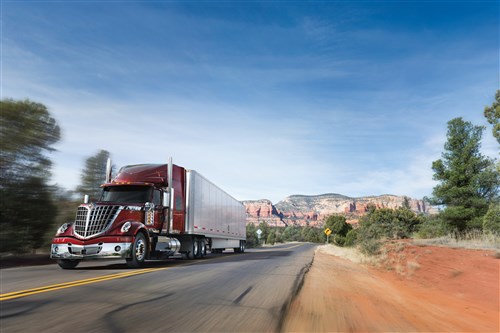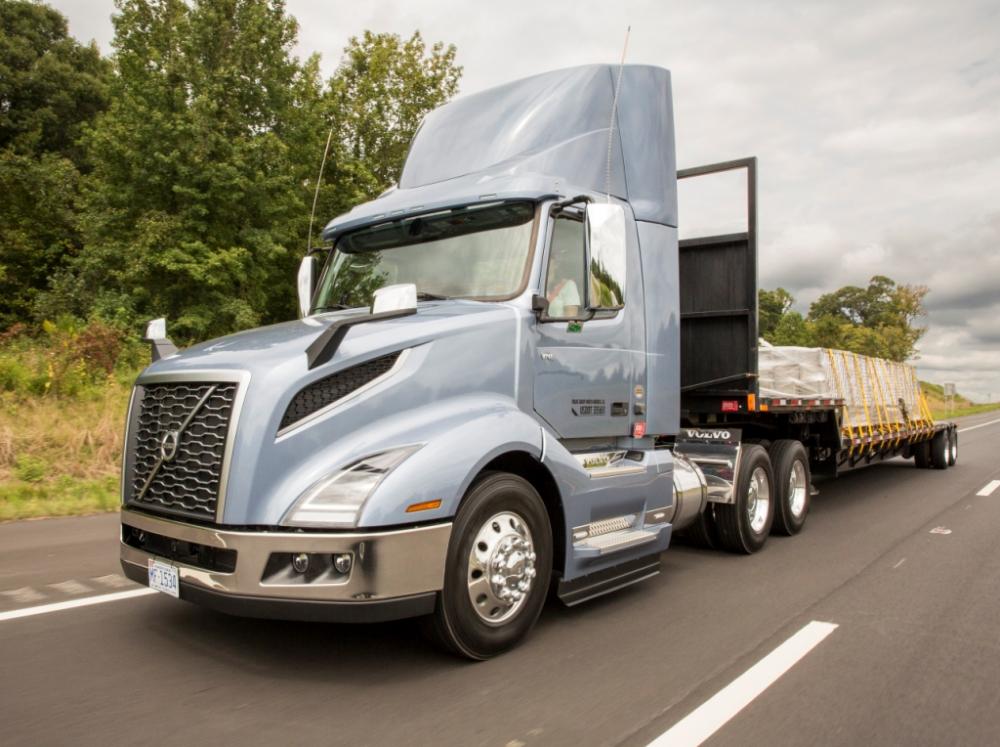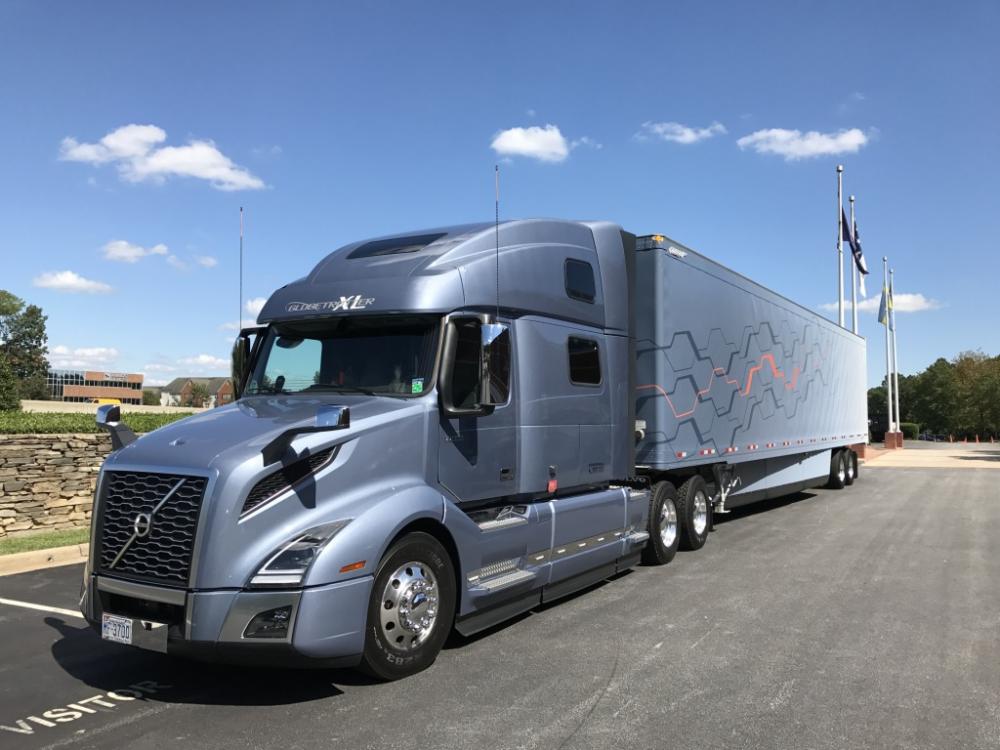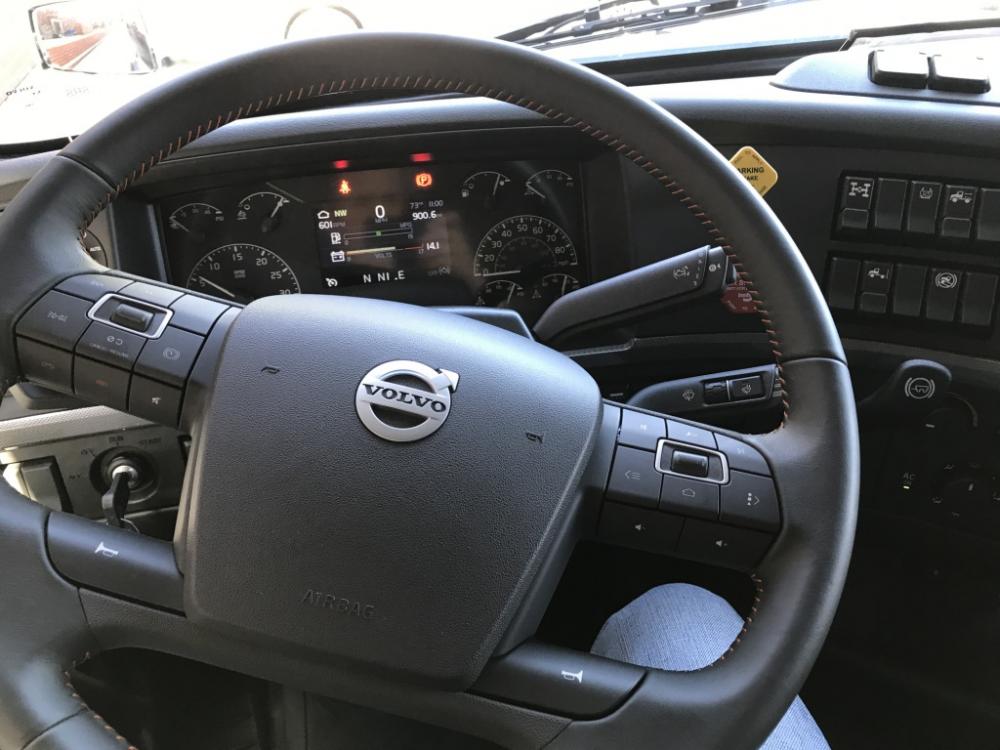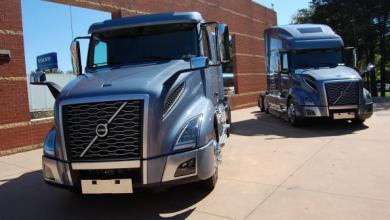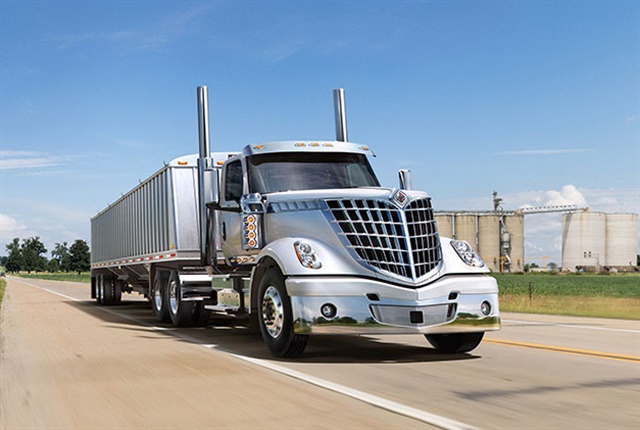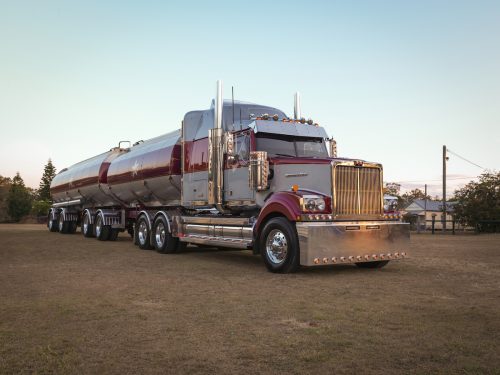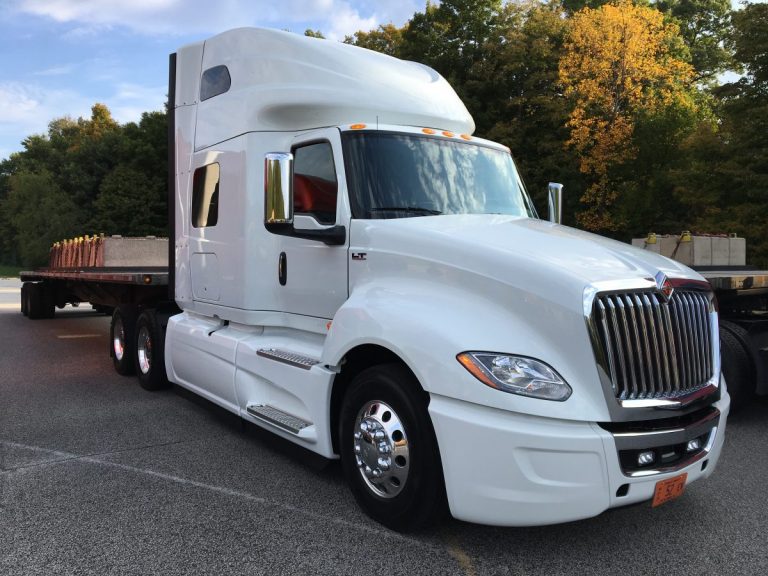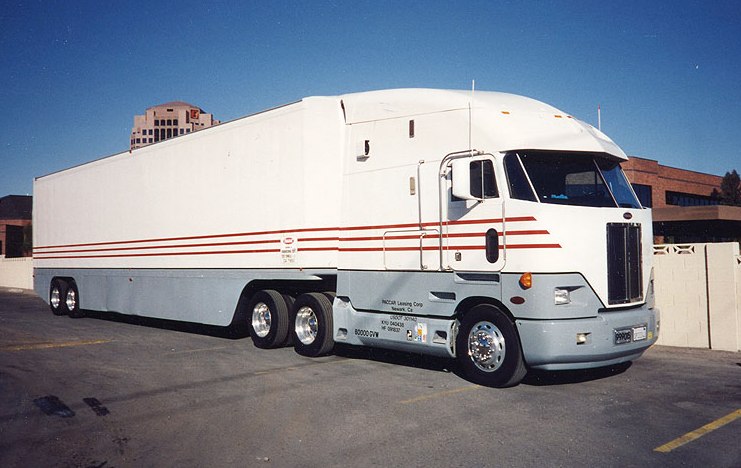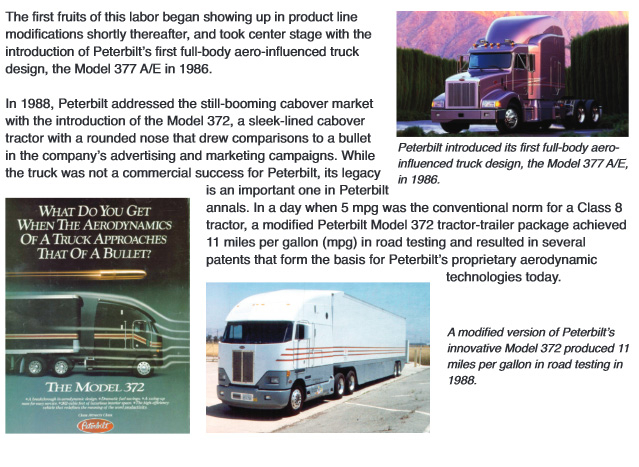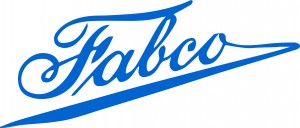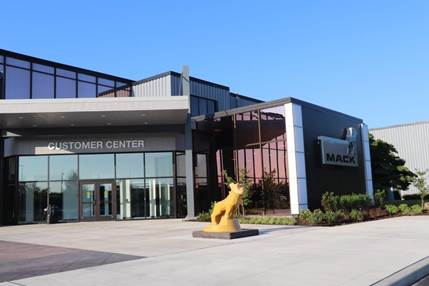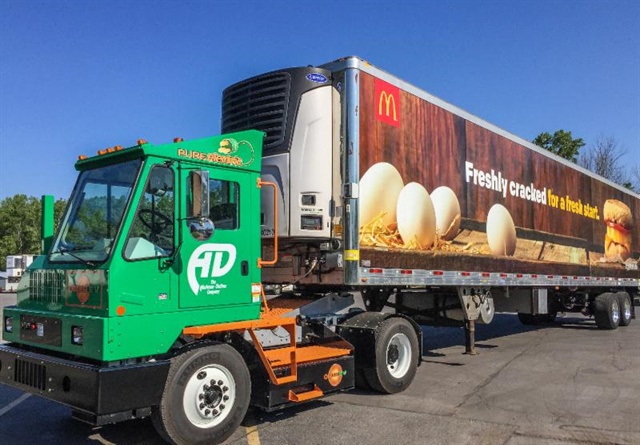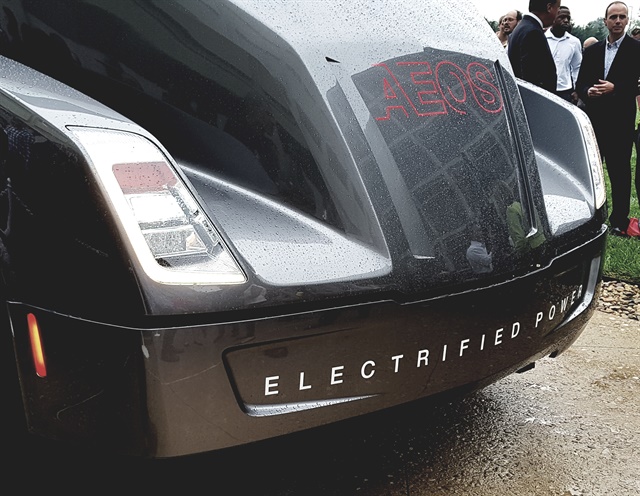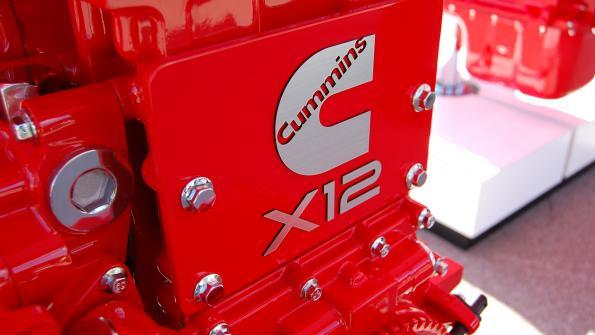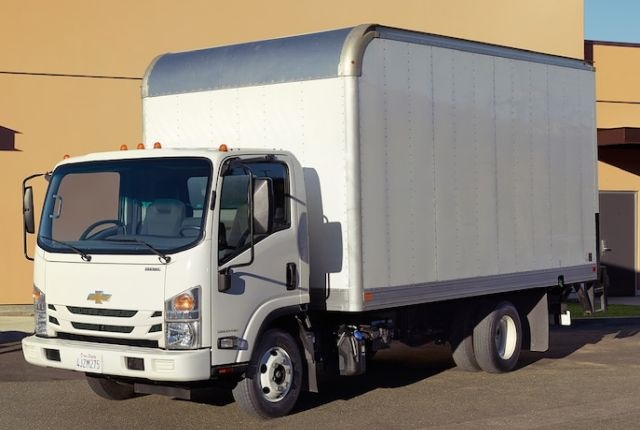
kscarbel2
Moderator-
Posts
17,893 -
Joined
-
Days Won
86
Content Type
Profiles
Forums
Gallery
Events
Blogs
BMT Wiki
Collections
Store
Everything posted by kscarbel2
-
International gives LoneStar an upgrade Truck News / September 11, 2017 LISLE, Ill. — International Truck on Sept. 11 announced major enhancements to its LoneStar truck, which combines maximum uptime and driver features with bold styling. The announcement was made during National Truck Driver Appreciation Week that ran Sept. 10-16, for a specific reason. International said the new truck was created with drivers in mind as a result of the company’s DriverFirst design philosophy, which actively asked for driver input on how to improve the interior design of trucks to better meet the needs of drivers themselves. “As we honor the more than 3.5 million professional truck drivers across America during National Driver Appreciation Week, it is fitting that we are unveiling the beloved American classic, the LoneStar with interior updates that maximize driver productivity and improve driver ergonomics and visibility,” said Michael Cancelliere, president, Truck and Parts, Navistar. Direct results of the driver input include an ergonomically designed interior with new digital information display, a new integrated stalk shifter integrating transmission and engine brake functionality, durable and easy to clean soft touch vinyl interior, and a stylish Diamond interior is standard. Doors, side glass, and cab mirrors were also redesigned to enhance visibility and reduce neck strain. The truck also features the classic, recognizable grille design. “One of the things we spent a lot of time on is the egress of the vehicle,” said David Majors, vice-president, product development. “We opened up the door four degrees, and we also placed the steps so that it makes perfect sense for when you’re entering and egressing the vehicle. We’ve also added the three points of contact to make sure there are no accidents getting in and out of the vehicle.” The new LoneStar was also built for maximum uptime, the company said. It contains a new single-canister aftertreatment system that is 60% smaller and 40% lighter and simplified for quicker servicing. As well, all key service points under the hood, inside the cab, and around the vehicle are ergonomically designed for easy access and servicing, and many components have been engineered with longer intervals between required maintenance. The truck also has an upgraded HVAC system with a max air-conditioning feature that can cool the cab more quickly. The company also claims the new vehicle has best in class defrost performance, which allows drivers to spend less time waiting for the windshield to clear, and more time driving to deliver their load. The new LoneStar is also up to 3% more fuel efficient than the previous generation thanks to a combination of the Cummins X15 engine, contoured hood, fenders and pedestal mirrors. As well, every LoneStar can be equipped as an option with OnCommand Connection, the company said. “Now more than ever, driver retention is one of the top concerns among fleets both large and small,” said Majors. “Therefore, enhancing the LoneStar at this time with critical driver-centric updates gives fleet operators and owners an additional tool to reward and retain drivers.” International confirmed the new Lonestar will be available as a day cab, 56-inch low-roof sleeper, 56-inch hi-rise sleeper, 73-inch hi-rise sleeper, and 73-inch sky-rise sleeper. The company is taking orders now and will begin market availability of the trucks at the beginning of 2018. For more information visit https://www.internationaltrucks.com/LoneStar. .
-
Volvo Unveils Next-Generation VNL Highway Tractor
kscarbel2 replied to kscarbel2's topic in Trucking News
Driving the new Volvo VNL James Menzies, Truck News / September 11, 2017 Volvo’s driver-centric approach to the design of the new VNL has resulted in a truck that’s incredibly comfortable to operate, and spend time in GREENSBORO, N.C. — The smartly designed new Volvo VNL has so many ‘why has nobody done that before?’ features, it’s little wonder that most of them were inspired by professional drivers. But Volvo’s global footprint also contributed to a redesign that’s comprehensively better, with ideas such as a reclining bunk, and sway bar, brought to this market for the first time from Europe. I recently had the chance to drive a Volvo VNL 740 on a 65-mile route near Greensboro, N.C., and it was the sway bar and the vastly improved cab ride it delivered that immediately grabbed my attention. With its new VNL series trucks, Volvo has taken the next step forward in cab ride, thanks to the addition of a sway bar offered on trucks with large sleepers. The sway bar is common in Europe, due to the high center of gravity of the cabover trucks preferred there, and their tendency to lean when cornering. But the sway bar is evidently useful on conventional trucks as well, and provides a noticeable improvement in how cabs with large sleepers perform. I’m surprised Volvo didn’t make a bigger deal out of its sway bar, being the first OEM to bring the technology to this side of the pond. On my recent drive over a combination of Interstate and secondary, two-lane roads, the sway bar provided a remarkably smooth ride. This cab simply does not lean. It evened out the bumps, made sharp lane changes feel more controlled, and eliminated the buffeting effect normally experienced when large vehicles pass in the opposite direction. The end result is an amazingly smooth ride, and will ensure drivers who experience a sway bar-equipped cab begin asking for one. Volvo has made the sway bar standard on VNL-series trucks with large sleepers, but it’s deleteable for those cost-conscious fleet who don’t want to splurge for the improved ride. But it’s a fairly inexpensive feature, and one that drivers will appreciate – maybe even demand – once they’ve experienced it. In addition to the sway bar, the new VNL also offers better visibility than the truck it replaces, thanks to a hood that better hugs the engine compartment and provides better sightlines to the ground. I drove a VNL 740, powered by a Volvo D13 engine rated at 425 hp and 1,750 lb.-ft. of torque, a typical fleet spec’. I was pulling a loaded flatdeck trailer, with a gross vehicle weight of about 77,000 lbs. The 12-speed Volvo I-Shift automated manual transmission was set up with adaptive gearing, meaning it operated in overdrive while in top gear at highway speeds, and seamlessly dropped down to 11th gear on secondary roads where I got the additional fuel economy benefits of direct drive. It’s a versatile transmission, ideal for running different types of highways or handling a combination of heavy and lightly-loaded – or empty – trips. Another immediate improvement in the new VNL is the sound quality while cruising at highway speeds. It’s incredibly quiet, thanks to a combination of the low cruising rpms we enjoyed due to downspeeding, and new removable, rubber floor inserts that mute sound from the road and engine compartment underneath the cab. These new floor mats also make access to the engine compartment much easier; it used to take more than an hour to access the hatch, because the passenger seat had to first be removed. Now, the floor mats can be pulled out, and a technician can access the engine from inside the cab in about 12 minutes. The new VNL was designed with plenty of input from drivers, and you can see evidence of this extensive consultation everywhere. Power outlets are located all over the place, including atop the dash where drivers tend to store their devices – eliminating the spaghetti effect of cords hanging from the dash to the area below, where power outlets have traditionally placed. There are even power outlets placed within reach of the upper bunk. Storage trays in the new truck come with removable inserts, making them easier to clean of spills or crumbs. Storage has been added throughout the cab, and a larger 70-inch sleeper has allowed Volvo to increase the size of cabinets, as well as the fridge and freezer. Seven different seats can be ordered in any trim level, with heated, cooled, and massaging seats available. The truck I drove had an NTL heated seat with back cycler, and was very comfortable. Everything about the truck was comfortable. The steering wheel now comes with head tilt functionality, and can be set exactly to the driver’s liking to afford the best sightlines to the new driver information display, as well as general comfort. The adjustability of the steering wheel will allow drivers of all stature to get comfortable. Some 21 buttons have been placed on the steering wheel, so drivers can access frequently needed controls without taking their hands off the wheel. The leather-wrapped steering wheel itself is comfortable to grasp. Orange stitching gives it a stylish, sporty look. The new dash is less industrial looking than what’s often found in a commercial vehicle, and more automotive-inspired. It’s less cluttered and easier to find the gauges or switches you’re looking for. This interior is nearly infinitely customizable. A modular frame rail allows for the placement of cupholders – big enough to accommodate a large Gatorade bottle, but adaptable enough to firmly grip a small Styrofoam cup – storage bins, or ram mounts. The door panel controls are more automotive-feeling; including the addition of single-touch window down functionality. All interior lighting is LED, and comes in various colors for different tasks – ie., a soft blue light for consulting credit cards or paperwork, and a brighter light for reading. A puddle lamp at the bottom of the door shines down on the area below the steps when the door is opened, so drivers are less likely to slip or step into a puddle when exiting the cab. The living environment has been completely remodeled, and can be ordered with a dinette set or a reclining bed. The two options can’t be combined at this time, but Volvo hasn’t ruled it out for the future. The reclining bed is a comfortable option for spending time in the sleeper watching TV, reading, or doing work. The dinette set may be preferred by drivers who want a formal dining area and don’t like the idea of snacking in bed. The cab comfort controls have been moved to the back wall of the sleeper, where they’re more accessible from a lying position. The truck I drove had a 70-inch mid-roof sleeper, which was spacious and well laid out. “The living environment was designed to improve a driver’s lifestyle while in the back of the truck,” Brian Balicki, chief interior designer, told me during a tour of a cutaway cab. When working on the interior design, he and his team consulted thousands of drivers, and also looked to the airline industry for inspiration. A direct result of this collaboration can be seen in the form of airplane-style window shades that can be quickly lifted or lowered, in the place of cumbersome snap-on covers. The new sleeper design also allows customers to spec’ a skylight, an option that wasn’t previously offered. The D13 that powered the VNL I drove was one of the first to feature turbocompounding. It’s a waste heat recovery system that takes heat previously lost out the exhaust stack, and puts it to work powering the truck. It’s not noticeable to the driver, as the additional horsepower generated is used to lessen the load on the engine and improve fuel economy, rather than to add power and performance. Volvo says turbocompounding allows extreme downspeeding, with cruise speeds of 1,000-1,200 rpm and peak torque available all the way down to 900 rpm. This provides up to a 6.5% fuel economy improvement when combined with 2.47 rear axle ratios, compared to a previous generation D13 with no turbocompounding, and 2.64 rear axle ratios, according to John Moore, product marketing manager. The new D13 can be ordered with or without turbocompounding, but you can expect to see about a 3% difference in fuel economy if you choose the TC version. Moore said the D13 with turbocompounding is “the most fuel-efficient engine Volvo has ever produced.” It’s available with either 425 or 455 hp. A new common rail fuel system in the 2017 engines also contributes to the quieter driving experience. Volvo’s driver-centric approach to the design of the new VNL has resulted in a truck that’s incredibly comfortable to operate, and spend time in. Evidence of its consultation with thousands of professional drivers can be found throughout the vehicle. And if fleets are equally attentive to the needs and demands of their drivers, I expect Volvo will sell a lot of these new VNLs. . -
Volvo Unveils Next-Generation VNL Highway Tractor
kscarbel2 replied to kscarbel2's topic in Trucking News
Volvo VNL ride and drive Sean Kilcarr, Fleet Owner / September 8, 2017 Journalists recently got a chance to pilot or ride shotgun in six pre-production units of the revamped VNL family of tractors built by Volvo Trucks North America (VTNA), which the OEM originally unveiled back in July. They included a high-roof VNL 860 model – considered the “flagship” of the rebooted VNL family – two VNL 760 high-roof sleeper models, two VNL 740 mid-roof units, and a VNL 300 daycab tractor. Pulling either dry van trailers or a flatbed loaded out with concrete blocks, the trucks were put through their paces on everything from fast-moving highways to rolling rural roads surroudning VTNA's headquarters in Greensboro, North Carolina. Photo gallery - http://fleetowner.com/trucks/volvo-vnl-ride-and-drive#slide-0-field_images-225911 -
Volvo Unveils Next-Generation VNL Highway Tractor
kscarbel2 replied to kscarbel2's topic in Trucking News
Volvo: Timing could not be better for VNL introduction Sean Kilcarr, Fleet Owner / September 7, 2017 OEM says resurgence in Class 8 orders combined with predicted long-haul sector growth dovetails well with VNL model reboot. GREENSBORO, NC. A sustained surge in Class 8 orders this year, alongside projected growth in the long-haul sector of the trucking market, has the executives at Volvo Trucks North America (VTNA) thinking the OEM’s overhaul of its VNL tractor family – especially the addition of a 70-in. sleeper model – could not have come at a better time. “The timing is very good; our products were aging and it showed. But now we are very well suited to benefit from a stronger market,” Magnus Koeck, VTNA’s vice president of marketing and brand management, explained to Fleet Owner here at a VNL ride and drive event at the OEM’s U.S. headquarters. He said its “pretty clear” that 2017 is turning out to be a better year than previously thought in terms of truck sales, with VTNA predicting Class 8 production for North America Free Trade Agreement (NAFTA) region will top 225,000 units this year; volumes which should only strengthen heading into 2018. Some of positive trends Koeck highlighted that will help boost commercial truck sales growth overall this year and next include: A stronger labor market and increased consumer spending that is driving GDP [gross domestic product] growth in the U.S – growth that hit 3% in the second quarter this year; A manufacturing sector that is “rebounding” this year, with “moderate growth” expected in 2018; Construction spending, which is currently at an all-time high, that will continue to experience a “gradual” increase; Diesel fuel prices that will remain relatively low, with the Energy Information Administration (EIA) at the moment projecting diesel to end 2017 averaging $2.66 per gallon before climbing to $2.81 per gallon for 2018. While Class 8 registrations slipped in U.S. & Canada overall in a year-to-year comparison, with the long-haul sector experiencing a decided dip in 2017, Koeck believes that trend will start reversing next year. Year-to-date Class 8 registrations hit 100,468 units in June this year, according to IHS Automotive data, down from 119,618 units year-to-date in June of 2016, with the long haul segment contracting to 41.5% of those registrations in 2017 compared to 46% in 2016. Yet Koeck believes that long-haul will return to 45% or so of Class 8 registrations in 2018 as freight volumes continue to strengthen. “The long-haul sector will come back strong and the regional haul sector will strengthen as well,” he said. Koeck also noted that the revamped VNL long-haul family will fully replace its “legacy” VNL models by early next year, with the legacy VNL 670 the only model to remain “in the mix” into the first quarter of 2018. . -
Heavy Duty Trucking / September 11, 2017 International Trucks will be rolling into the inaugural North American Commercial Vehicle Show later this month with a seriously-overhauled LoneStar. In a teleconference Monday morning to outline the various enhancements and new features on retro-styled Class 8 tractor, Dave Majors, vice president, product development, Navistar, said the new LoneStar is yet another signal to the industry that International Truck is focused on uptime and delivering the best trucks in the industry that drivers want to drive. According to Majors, the Lonestar’s “striking” aerodynamic appearance and “breakthrough” functional innovations inside and out are the results of International DriverFirst and Advanced Classics design philosophies, in which technology and innovative styling converge with next-generation aerodynamic design to deliver superior fuel efficiency. Majors said the new LoneStar also sets a higher standard for comfort through improved driver ergonomics and a quieter cab. "Over the past decade drivers have come to love the iconic status of the LoneStar tractor's exterior styling and appearance with the distinctive grille and sloped hood that were inspired by International's D-Series trucks," said Majors. "Based on this feedback, we wanted to incorporate much of what we've recently learned from drivers and focus our engineering on an all new driver-centric interior while maintaining the iconic exterior look of the truck. As a result, we've made major improvements to the LoneStar in vehicle uptime performance and multiple new and improved features that enhance driver appeal." Among the new features that International has added to the LoneStar are: A new, single-canister aftertreatment system, Majors said is now 60% smaller and 40% lighter than its predecessor and has also been simplified for quicker servicing. All new cab wiring and an in-cab power distribution module that is inside the truck, for better protection from the elements. International has moved all key service points under the hood, inside the cab, and around the vehicle are ergonomically designed for easy access and servicing, and many components have been engineered with longer intervals between required maintenance. A completely revamped HVAC system, that Majors said now delivers outstanding comfort and visibility. It is not only more robust and reliable, drivers will be impressed by the quick defrost functionality. During testing at a frigid 0°F, Majors said the LoneStar's bMAX defrost cleared 100% of the windshield in under 30 minutes from start-up time. Additionally, Majors noted, International’s DriverFirst design philosophy actively asked for driver input on how to improve the interior design of our trucks. As a result, the LoneStar features an all new, ergonomically designed interior with new digital information display, a new integrated stalk shifter integrating transmission and engine brake functionality, durable and easy to clean soft touch vinyl interior, and stylish diamond interior is standard. Majors said drivers will notice that the doors, side glass, and cab mirrors have all been redesigned to enhance visibility and ultimately helping to reduce neck strain and fatigue over the long haul. Additionally, International redesigned the fuse panel in the passenger-side dash. “Drivers told us they needed a flat area to write on,” Majors said. “This redesign does just that. But we also added deep channeling around the electronics to keep any spilled drinks out of the electronic components housed in that compartment.” Other in-cab improvements, Majors said, focused on safety and reducing driver fatigue. These include vastly reduced sound levels inside the cab, improved front, and side, visibility, redesigned and repositioned pedestal mirrors and an all-new instrument cluster with improved graphics and easier-to-read dial faces. Another major upgrade is the addition of the Cummins X15 engine as an option with ratings ranging from 485 to 605 horsepower. When combined with the Lonestar’s contoured hood, fenders and new aerodynamic pedestal mirrors, Majors said the new X15 option is up to 3% more fuel efficient than the previous generation of the tractor, and noted that the truck will be offered in specialized ratings that will allow customers to dial in the ideal balance of performance and efficiency required for any on-highway operation. International will unveil upgraded Lonestar tractor later this month at the NACV Show in Atlanta. The new models will begin appearing at International dealerships nationwide in early January. Related reading - https://www.internationaltrucks.com/trucks/lonestar .
-
Matt Cole, Commercial Carrier Journal (CCJ) / September 11, 2017 Daimler Trucks is recalling a few dozen Western Star 4900 trucks in which the weight of the front axle could exceed the spring capacity. The recall affects approximately 38 model year 2017-2018 trucks manufactured between Nov. 18, 2016, and July 24, 2017. The manufacturer says overloaded springs could cause the front axle to separate from the truck, causing a crash. Daimler will begin notifying owners on Oct. 20 and will replace the axle springs for free. Owners can contact DTNA with questions at 1-800-745-8000 with recall number FL-745. The National Highway Traffic Safety Administration’s recall number is 17V-521. .
-
Navistar Rebounds with $37 Million Quarterly Profit
kscarbel2 replied to kscarbel2's topic in Trucking News
Navistar sees quarterly profits for second time in 5 years, gains $37M in 2017 3Q James Jaillet, Commercial Carrier Journal (CCJ) / September 7, 2017 Navistar International Corp., the parent company of International Trucks, reported Wednesday a net income of $37 million for the third quarter of the 2017 fiscal year, which ended July 31. The quarter was only the second time since 2012 that Navistar reported a quarterly profit, with losses stemming from warranty repairs of its defunct MaxxForce engine and, in some cases, sluggish truck sales. In the same quarter in 2016, Navistar reported a loss of $34 million. Revenus in 2017’s third quarter were $2.2 billion, up 6 percent from the same period last year. Navistar says the revenue gains came primarily from its truck segment, whose revenue grew 10 percent from the same period a year ago, the company says. Through the first 9 months of the fiscal year, the company reported a net loss of $105 million. Truck sales accounted for $1.5 billion of the company’s revenue, and its income grew to $7 million — up $61 million from the same period a year ago. Navistar’s truck segment lost $54 million in 2016’s third quarter. Through the first 9 months of the 2017 fiscal year, the company’s truck segment has lost $118 million. Sales in the company’s parts segment fell $11 million from the same period last year, but the segment still recorded a profit of $157 million. The segment saw a profit of $152 million in the same quarter last year. Despite gains in its truck and parts segments, the company’s corporate and eliminations segment lost $154 million, offsetting the gains elsewhere. The company did not specify what these losses were directly attributable to, other than corporate restructuring. -
Commercial Carrier Journal (CCJ) / August 29, 2017 The National Highway Traffic Safety Administration (NHTSA) recently announced a recall affecting certain International trucks. The recall from Navistar on International trucks affects approximately 224 trucks with Cummins ISX15 Performance Series engines – the same recall that was issued for more than 1,700 Kenworth and Peterbilt trucks and approximately 74 Freightliner and Western Star trucks. In these engines, the fuel pump’s drive gear could slip on its drive shaft, resulting in a loss of function, causing the engine to stall. International’s recall affects model year 2018 International HX and LT trucks manufactured between late November 2016 and early April 2017. Cummins began notifying owners of the affected engines on Aug. 11 and will replace the fuel pumps for free. NHTSA’s recall number is 17V-406. .
-
Truck News / September 6, 2017 Truck industry analyst FTR reported today that preliminary Class 8 net orders for August hit 20,700 units. That number represents a 14% increase month-over -month and is 50% better than a year ago. Class 8 orders met expectations as market momentum continues to build ahead of 2018. August orders should help fill up remaining 2017 build slots, FTR said. Don Ake, vice-president of commercial vehicles at FTR, said: “August orders continue the positive trend in the Class 8 market. Orders were up for the third straight month, and it looks like May’s 16,500 orders will be the low point for the year. Orders are expected to increase in September, leading into robust order activity in Q4. Freight continues to show some impressive growth. This has created capacity tightness in some regions which is expected to spread to more areas as economic growth expands. The capacity crunch will be exacerbated by the ELD mandate, spurring demand for trucks and trailers in 2018.”
-
Run on Less Kicks Off as Participants Aim for 9 mpg
kscarbel2 replied to kscarbel2's topic in Trucking News
-
Heavy Duty Trucking / September 7, 2017 Run on Less, billed as a first-of-its-kind national fuel efficiency roadshow, has kicked off this week from multiple locations around the country. The event is led by the Trucking Efficiency Operation of the North American Council on Freight Efficiency and Carbon War Room. Seven drivers, behind the wheels of differently spec’d trucks from seven different fleets, will participate in the three-week fuel-efficiency challenge, which wraps up at the North American Commercial Vehicle Show in Atlanta Sept. 25-28. The trucks will be monitored throughout the event, traveling through varied terrain and different traffic and weather conditions. Daily fuel economy, including dollars and gallons saved, will be reported on the Run on Less website. The seven participating fleets are Albert Transport, PepsiCo’s Frito-Lay Division, Hirschbach, Mesilla Valley Transportation, Nussbaum Transportation, Ploger Transportation, and U.S. Xpress. The goal of Run on Less is to demonstrate how Class 8 trucks can use different technologies to achieve the best fuel economy possible. With a goal of achieving 9.0 mpg, the trucks have been fitted with different technologies, including 6x2s, automated transmissions, aerodynamics, and other technologies that assist with improved freight efficiency. To keep up to date with the drivers and trucks, visit runonless.com .
-
International Truck Launches New 12.4L Diesel Engine
kscarbel2 replied to kscarbel2's topic in Trucking News
International Takes New A26 Engine on Tour Heavy Duty Trucking / September 7, 2017 International Truck is taking its new A26 12.4L engine on the road to dealers throughout the North America with the launch of the International A26 Mobile Training Tour. The tour is scheduled to visit more than 100 International Truck dealer locations to provide an up close and personal opportunity for sales, parts, and service personnel, and customers to experience the newly designed engine. Trainers will be on hand to demonstrate the increased fuel efficiency, reduced noise, lower weight, and focus on uptime as they teach the ins and outs of the engine. The tour consists of two trailers and is scheduled to run through the spring of 2018. "Since its introduction, the International A26 engine has continued to impress with its outstanding fuel economy and light weight while providing the highest level of uptime for our customers," said Michael Cancelliere, president, truck, and parts. "We are excited for our dealers and customers to learn just how impressive this engine is firsthand." Unveiled at the Technology & Maintenance Council annual meeting in February, the A26 started shipping in new trucks in late June. The mobile tour will spend two days at each dealer location and provide a series of training sessions, which will include hands-on engine disassembly and component identification. Many dealerships will also be holding A26 engine customer training events concurrent with sales training. -
Evan Lockridge, Heavy Duty Trucking / September 6, 2017 Navistar International Corp. on Sept. 6 announced that it rolled back into the black during its fiscal third quarter with a profit of $37 million, although it would have been higher had it not been involved in litigation over its earlier model engines. The profit of 38 cents per share compares to a year-earlier loss of $34 million, or 42 cents per share, while revenue increased 6% to $2.2 billion, primarily due to an increase in truck segment volumes, according to the truck and engine manufacturer. The third quarter of fiscal 2017 had adjustments that including a $31 million charge for a legacy engine litigation matter, $6 million of pre-existing warranty charges, and a $3 million net benefit in asset impairments and restructuring costs. "We returned to profitability this quarter thanks to strong operational performance across the board, highlighted by a 15% increase in chargeouts and solid market share gains amid flat industry conditions, and strengthening margins," said Troy A. Clarke, Navistar chairman, president and CEO. "We also moved ahead with new products and solutions that position us well for ongoing growth, while continuing to restructure our business to improve our future competitiveness." Chargeouts are defined as trucks that have been invoiced to customers, with units held in dealer inventory primarily representing the difference between retail deliveries and chargeouts. Truck segment net sales increased 10% to $1.5 billion compared to third quarter 2016, due to higher volumes in its core markets of Class 6-8 trucks and buses in the United States and Canada, plus an increase in Mexico truck volumes, and the production ramp up of GM-branded units manufactured at Navistar's Springfield, Ohio plant. Chargeouts in the company's core markets increased by 15% during the third quarter. In the third quarter of 2017, Truck segment results improved by $61 million year-over-year, recording a $7 million profit compared to a $54 million loss in the fiscal third quarter of 2016. The improvement was primarily driven by the impact of higher volumes in core markets and Mexico, lower used truck losses, and lower restructuring charges, partially offset by lower other income, according to the company Parts segment net sales declined $11 million to $586 million compared to third quarter 2016 but recorded a profit of $157 million, up 3% compared to third quarter 2016. Global operations net sales were flat compared to the prior year at $84 million, but moved from a $5 million loss a year earlier to a $3 million profit in the most recent quarter. For the third quarter 2017, the financial services segment recorded a profit of $23 million, down $3 million compared to third quarter 2016. Navistar also reported its alliance with Volkswagen Truck & Bus is moving forward as planned. “The two companies are finding significant opportunities to leverage their combined scale through their procurement joint venture, while also pursuing technology collaboration on a number of fronts,” Navistar said in a news release. The company reiterated its 2017 guidance that retail deliveries of Class 6-8 trucks and buses in the U.S. and Canada are forecast to be in the range of 305,000 units to 335,000 units for fiscal year 2017 and that Navistar’s full year revenue is expected to be similar to 2016. "Looking ahead, I like our position as we enter the prime selling season," Clarke said. "I feel good about the fourth quarter and look forward to finishing the year on a strong note."
-
Daimler to use Prestolite Alternators in 2019, 2020 models
kscarbel2 replied to kscarbel2's topic in Trucking News
Prestolite Electric was acquired by Chinese government-backed Zhongshan Broad-Ocean Motor Co. Ltd. in 2015. Some North American customers might take issue with having party-built starters and alternators in their DTNA vehicles. -
Daimler to use Prestolite Alternators in 2019, 2020 models
kscarbel2 posted a topic in Trucking News
Heavy Duty Trucking / September 5, 2017 Prestolite Electric, manufacturer and supplier of starters and alternators, has been awarded standard position by Daimler Trucks North America on several new commercial vehicles launching in multiple markets between late 2019 and early 2020. DTNA has selected products from Prestolite’s IdlePro family of alternators to appear on Freightliner severe-duty and Western Star commercial trucks in North America, as well as Freightliner right-hand drive trucks bound for Australia and New Zealand. Prestolite’s IdlePro and IdlePro Extreme alternators include advanced features like Isolated Ground Technology, which is designed to protect engines from potentially severe electrolytic damage caused by stray voltage. “Being awarded standard position with Daimler Trucks North America further reinforces Prestolite Electric’s position as a global market leader in rotating electrical technology,” said Nick Laenen, vice president, North America, South America, Australia sales and marketing, Prestolite Electric. “The new IdlePro and IdlePro Extreme family of alternators offers enhanced performance capabilities and industry-best output at low engine speeds, and we’re excited for the opportunity to make this proven technology available to Daimler’s discerning customers.” -
Dodge: 2018 pickups built for commercial upfit needs Fleet Owner / August 31, 2017 CHELSEA, MI. Touting its payload, torque and towing power, Dodge Truck (aka. Ram Truck) today officially unveiled its new heavy-duty and commercial pickup truck lineup for 2018. Back in June, Dodge gave industry journalists a sneak peek at the new models during Fiat Chrysler’s What’s New ride-and-drive event at the Chelsea Proving Grounds. Adrian Ratza, brand manager for Chassis Cabs at Dodge, told Fleet Owner that Dodge’s new commercial pickup trucks were built to handle the versatile upfit needs of vocational fleets and municipal applications. Dodge’s commercial trucks are equipped with backup cameras and safety technologies that Ratza said comply with government standards and regulations. “As a society, we’ve come to expect customizable options,” he explained. “We’ve tried to make it as convenient as possible for the upfitters.” Here are some details of Dodge’s new commercial line: 2500, 3500 heavy-duty pickup For 2018, Dodge continues to offer three-quarter and one-ton pickups with 31,210 lbs. of towing, 7,390 lbs. of payload and 900 lb.-ft. of torque. It also offers more features and improved ride quality with a five-link coil suspension or optional air suspension on Dodge 2500 and a supplemental air bag suspension option on Dodge 3500. New features for 2018 also include: Remote exterior switch in truck bed to activate LED bed lights Backup camera now standard on all models Fleet Telematics Module for vehicle tracking Towing – Up to 31,210 lbs. with Ram 3500 Towing – Up to 17,980 lbs. with Ram 2500 Payload – Up to 7,390 lbs. with Ram 3500 Power – 900 lb.-ft. of torque with 6.7-liter Cummins engine Power – 410 horsepower and 429 lb.-ft. of torque with 6.4-liter HEMI V-8 engine Engine options include: 5.7-liter HEMI V-8 engine delivering 383 horsepower at 5,600 rpm and 400 lb.-ft. of torque, and features variable-valve timing (VVT) 6.4-liter HEMI V-8 delivers 410 horsepower at 5,600 rpm and 429 lb.-ft. of torque at 4,000 rpm, and features VVT with Fuel Saver Technology cylinder deactivation 6.7-liter Cummins High-Output Turbo Diesel produces up to 385 horsepower at 2,800 rpm and 900 lb.-ft. of torque depending on application 3500, 4500 & 5500 Chassis Cab Dodge 3500, 4500 and 5500 Chassis Cab trucks are engineered and designed for extreme daily work and to be upfitter friendly, the company noted. Backup cameras made standard on Dodge 3500 Chassis Cab (10,000 GVWR), and Dodge’s Uconnect 8.4 touchscreen radios now include Google Android Auto and Apple Car Play. In addition, Chassis Cab trucks can be ordered with an optional ParkSense Package, which includes a front park assist system. The new cabs also come with handsfree technology with Bluetooth capability on radios. Engine options include 6.4-liter HEMI V-8 gas engine that powers trucks with 370 horsepower at 4,600 rpm (410 horsepower at 5,600 rpm under 10,000-lb. GVWR) and 429 lb.-ft. of torque at 4,000 rpm, and features variable-valve timing (VVT) and Fuel Saver Technology cylinder deactivation. In addition, a 6.7-liter Cummins diesel engine is available with high-output option producing 325 horsepower at 2,400 rpm and 750 lb.-ft. of torque at 1,500 rpm. Other features include: Electronic stability control on all models Dual fuel tank capacity of 74 gallons (52-gallon tank plus 22-gallon tank) 15,000-mile oil change intervals on Cummins diesel Dual alternator systems up to 440 amps Fit-to-use backup camera and front/rear parking sensors In an effort to make its new lineup more "upfitter friendly," Dodge said it ensured: Industry standard frame lengths of 60, 84, 108 and 120 inches No components or lines above the rear frame rails Through-the-frame plumbing and electrical Diesel exhaust fluid tank (DEF) refill port located at the rear of the cab on the driver’s side Photo gallery - http://fleetowner.com/hd-pickup-van/ram-2018-pickups-built-commercial-upfit-needs#slide-0-field_images-225561
-
Heavy Duty Trucking / September 5, 2017 Meritor has acquired the product portfolio and related technologies of Fabco Holdings and its subsidiaries under undisclosed terms. Fabco’s suite of products will expand Meritor’s portfolio of complementary products, including transfer cases, specialty gear boxes, auxiliary transmissions and power take off units for medium-, heavy- and extra-heavy vehicles and for on- and off-highway, construction, defense, rail, and other industrial applications. These products are available to both original equipment and aftermarket customers. In addition to expanding Meritor’s global ability to offer complementary products, the acquisitiion will also help the company diversify its customer base and expand into the rail, oil, and gas industries not currently served by Meritor. "Acquiring this suite of products and technologies provides Meritor with new products and customers in important markets that we expect will contribute to significant growth in our specialty, defense and off-highway business units," said Jay Craig, CEO and president. "This transaction fits well with our plan to pursue strategic growth initiatives while maintaining a balanced approach to capital allocation as part of our M2019 plan." .
-
Volvo gives Mack Truck Customer Center a facelift
kscarbel2 replied to kscarbel2's topic in Trucking News
Volvo opens newly remodeled Mack customer center Fleet Owner / August 31, 2017 Mack Trucks recently celebrated the opening of its remodeled Mack Customer Center based in Allentown, PA. The $3 million renovation features facility enhancements, a reconfiguration of the floor plan and the addition of multiple interactive displays, Mack noted. “We’re pleased to celebrate the investment into our new Mack Trucks Customer Center, and we look forward to customers from all over the world visiting this location to learn more about Mack products, services and support,” said Jonathan Randall, senior vice president of sales, Mack Trucks North America. Within the Mack Customer Center, Mack houses a product showroom, the 360-degree Bulldog Theater, office and meeting space, and the Mack Shop. A test track is located around the facility for customers to test drive Mack models. The redesign work was initiated in April 2016. Key partners on the project include Alliance Engineering, Mohawk Construction, Blue Rock Construction and RES Exhibits. As part of the renovation, Mack noted it also supported the transformation of the Mack Trucks Historical Museum located within the facility. “Mack has been around a long time, but we’ve never lost our passion or focus on the customer,” Randall said. “The Mack Customer Center spotlights our commitment to developing products and services driving the success of our customers’ businesses.” -
Truck News / August 29, 2017 ALLENTOWN, Penn. – Mack Trucks opened its new, remodeled Mack Customer Center in Allentown, Penns. today. The new renovation cost Mack $3 million and includes facility enhancements, a reconfiguration of the floor plan and the addition of multiple interactive displays to offer a more engaging experience for Mack customers. “We’re pleased to celebrate the investment into our new Mack Trucks Customer Center today, and we look forward to customers from all over the world visiting this location to learn more about Mack products, services and support,” said Jonathan Randall, senior vic- president of sales, Mack Trucks North America. The new customer center also features a product showroom, the 360-degree Bulldog Theater, office and meeting space, and the Mack Shop. A test track is located around the facility for customers to test drive Mack models. The redesign work was initiated in April 2016. Key partners on the project include Alliance Engineering, Mohawk Construction, Blue Rock Construction and RES Exhibits. In addition to the interactive displays added throughout the 160,000 square-foot-facility, highlighting the brand’s products and uptime services, a “selfie” station is included so visitors can take and immediately share on social a photo with a Mack truck. As part of the renovation, Mack also supported the transformation of the Mack Trucks Historical Museum located within the facility, reorganizing the space to be more visitor-friendly. A new recognition wall at the entrance to the museum acknowledges dealers and others who donate to the Museum. “Mack has been around a long time, but we’ve never lost our passion or focus on the customer,” Randall said. “The Mack Customer Center spotlights our commitment to developing products and services driving the success of our customers’ businesses.” .
-
Cummins readies next-gen, future commercial power
kscarbel2 replied to kscarbel2's topic in Trucking News
Closer look: An electric-power truck from a global diesel leader Aaron Marsh, Fleet Owner / August 30, 2017 Though a sudden downpour tangled its "sneak peek" unveiling a bit, it couldn't dampen onlookers' enthusiasm for the AEOS all-electric Class 7 truck Cummins, Inc. showed off Tuesday at its Technical Center in Columbus, IN. When Cummins — a company that has built its global core business and reputation on diesel power — sets its sights on electric powertrains, people sit up and take notice. But with the growing momentum around the potential for electric commercial vehicles, what's the likelihood that this alternative power could make real inroads in North American trucking, where diesel is the undisputed king of over-the-road? Julie Furber, executive director of Cummins' Electrification Business Development Initiative, noted the company has been testing out prototype electric and range-extended electric vehicles over the last decade. She conceded that electric power is likely to appear in other commercial vehicles before long-haul trucks. Even so, the company believes there are applications for commercial electric powertrains that make sense today. "We see transit bus, we see underground mining, we see material handling and some other markets, and then it'll move into perhaps some municipal vehicles and school buses and things like that," she told Fleet Owner. "I think trucking will be a bit later. There are some things that have to advance for electric power in trucking to make sense," she added. Those include cost-effectiveness, where the cost of electric powertrain components needs to continue to drop, "which it is," Furber noted. And power density also needs to improve so that battery size and weight necessary to power something like a heavy duty truck is more compatible with trucking needs. Still, "I think what you'll see is that fleets will have a mixed bag of powertrains in the end, where some of their missions which are more sensitive in terms of things like emissions [restricted] zones will be fully electric," Furber said. For other duty cycles or where range needs are greater, Cummins anticipates that electric powertrains will be range-extended — perhaps with downsized diesel engines to generate power when batteries are depleted — or will incorporate hybridized configurations. The reality for North American trucking, though, is that "you'll still have long-haul trucks for many years to come that will be diesel-powered," Furber said. Photo gallery - http://fleetowner.com/emissions/closer-look-electric-power-truck-global-diesel-leader#slide-0-field_images-225501 -
Electric Yard Truck Deployed to McDonald's Distribution Network Heavy Duty Trucking / August 31, 2017 Orange EV and The Anderson DuBose Company are deploying an all-electric Class 8 yard truck in the McDonald’s distribution network. The Orange EV T-Series electric yard truck replaced a diesel model at The Anderson DuBose Company’s Rochester, New York, distribution center, where it manages and moves dispatch trailers. The truck is seen as an important step in the sustainability efforts of Anderson DuBose and McDonald’s. Switching to an all-electric yard truck will significantly reduce the company's carbon footprint while also supporting the company’s customer commitment to sustainability. Each year, Anderson DuBose sets aggressive sustainability targets to reduce electricity consumption, diesel fuel usage, and waste-to-landfill. Anderson DuBose said drivers report that the new truck is smooth, quiet, cool and clean in addition to being environmentally friendly. “I’ve heard nothing but great comments from the drivers," said Tom Hank, general manager of the Anderson DuBose Rochester facility. "Orange EV’s truck is more comfortable and our operators really like the quiet and smooth operation. Management is pleased that we can provide a safer and healthier working environment – the truck has no engine and no emissions." The Anderson DuBose Company is a distribution company based in Lordstown, Ohio, and it works closely with the other members of the North American Logistics Council to identify and share best practices. "Being the first to identify the Orange EV truck and work through the steps to on-board the vehicle enables us to be a resource for the other distributors," said Hank. "They can visit, observe truck operations, understand our design and business case, and hopefully deploy more trucks throughout the country." .
-
Cummins readies next-gen, future commercial power
kscarbel2 replied to kscarbel2's topic in Trucking News
Cummins Taking Long View on Alternative Power Heavy Duty Trucking / August 30, 2017 COLUMBUS, IND. — For 98 years, Cummins has been powering trucks and buses around the globe, and the company said on Aug. 29 that it has every intention of being in that same position 98 years from now. Cummins executives stressed that they will continue to deliver the right powertrain for any marketplace anytime in the future, regardless of the energy source. "Energy diversity is the key to the future, and a one-size-fits-all approach is no longer viable," said Jennifer Rumsey, vice president and chief technical officer. "At this point in time, we believe there is a place for a wide range of technologies from diesel and natural gas to electric. "These technologies will evolve in the coming years," she continued, "and Cummins is capable and ready for this range of power technologies to meet our customers' needs today and in the future." The message was clear; anyone who believes Cummins' best days are behind it had better think again. These are certainly good times for the engine maker, currently holding a 37% market share in the heavy-duty engine space where a heavy presence of captive engines can leave the independent engine maker at a pricing disadvantage. Brett Merritt, executive director, EBU On-Highway Business, said the company commands nearly 80% of the North American medium-duty market and more than 90% of the school and transit bus markets. "Cummins is a technology company, first and foremost," he said. "Whether you're talking about diesel combustion, emissions catalysis or controls integration, we have the technical expertise combined with market knowledge to deliver technical innovations in the future." And to that end, the company is investing $700 million annually in research and development to stay on the leading edge of emerging technologies -- some of which involves marrying proven diesel technology with battery and electric technologies that meet regulatory requirements, societal demands, and customers' needs. Cummins is quite confident that diesel engines will be powering heavy trucks for many years to come, especially in the long-haul sector. "Twenty years from now, we will still be using internal combustion engines running on conventional fuels or unconventional fuels," said Srikanth Padmanabhan, president of Cummins' Engine Business, noting that they may not be the engines that we are familiar with today. "By that time, all ICE will have some form of mild hybridization and/or accessory drives, but ICE will continue to be an important player in global transportation." Padmanabhan said that whichever technologies may emerge in the next 15 to 20 years. it will be Cummins' responsibility to make sure customers get the right technology, not just a new technology for technology's sake,but something reliable and efficient that meets both the customers' and society's needs. Energy Diversity While electrification has seen very heavy exposure in the mainstream press in the past couple of years, Padmanabhan said Cummins has been working on this for over two decades. "Electrification makes sense in some areas, but not all," he said. "We know from real data and real-life experience where it works, where it makes sense and why we should use it." Cummins seems well placed to explore the potential for electrification because of its previous experience in power generation as well as engine design and development. Batteries supplemented with some form of high-efficiency, low-emission ICE seem best able to bridge the gap between 100-mile local trucks and 300-mile regional trucks. The company is now developing a high-efficiency spark-ignited engine that it says can deliver diesel-like performance and durability across a range of liquid fuels, like ethanol, methanol, and gasoline, while meeting the most stringent emissions requirements. Natural gas and diesel both figure prominently in this research. Engineers and scientists are also investigating the viability of alternatives like bio-fuels, synthetic fuels, and hydrogen. And, with its partners, Cummins is looking at projects focused on Proton Exchange Membrane and Solid Oxide Fuel Cell technologies. "Cummins is partnering with a few different fuel cell providers to develop that technology," said Rumsey. "We have been working for a number of years on those technologies." Diesel Still Has a Future Next spring, Cummins will introduce the 12-liter X12 engine, which will boast the highest power-to-weight ratio in the industry. It's targeted at vocational, regional and weight-sensitive bulk-haul applications. It’s 600lbs lighter than the closest 13L engine and 150 lbs lighter than the closest 11L engine. The X12 is derived from the ISG first introduced in 2013 as a global engine platform. It made its first appearance a year later in a joint venture with the world’s largest independent engine maker, Beiqi Foton Motor Co. Ltd. of China. Foton now uses the ISG diesel in a new truck series developed with Daimler. Cummins said the engine in ISG trim already has more than a billion miles under its belt and is ready to take on North America. While on a tour of the technical center, reporters were shown, but were not allowed to photograph, the next generation X15 engine, slated to launch in 2022. Cummins said it will be capable of meeting 2027 GHG rules five years ahead of the legislated requirement --and without using the feared waste heat recovery system. This 15 L engine will be 300 lbs lighter than the current X15, with the height of a 13 L engine, ensuring efficient installations in future ultra-aero trucks, both conventional and cabover. And natural gas remains a viable alternative to diesel, in a way similar to electric vehicles. It's still best suited to shorter ranges and a return-to-base operationwith a fuel supply. Range is limited by the size of the fuel tanks, but it does work in many instances, and it can be used to power range-extended battery electric vehicles. Cummins revealed its latest Near Zero natural gas engines during the media event in Columbus. According to Cummins, end users will find the Near Zero natural gas engines are an equivalent performance option to diesel and, like the latest clean-diesels, these produce little to no emissions. Cummins said it managed a 90% reduction in NOx, getting output down to just 0.02 gm/bhp/hr. A growing crowd of observers seems ready to pronounce diesel engines a marooned technology while electric systems seem poised to emerge as the power technology of choices. Cummins, however, would beg to differ. Padmanabhan sees diesel as a safe bet for at least the next 20 years, and likely far beyond that. It's simply has no equal in terms of energy density, portability, and flexibility. Used as a range extender with battery electric systems, diesels can be made to run at near-zero emissions levels because they operate at a steady state, with zero transient cycles to worry about. Diesels will emerge with varying degrees of hybridization and with various off-engine accessory drives that help to minimize parasitic losses. And trucks as a whole will become more efficient, which will require less power to run at highway speeds, so smaller displacement engines could well find a home in heavy-duty long-haul applications, with much improved fuel efficiency. "We succeeded during previous major disruption periods because Cummins is a technology company that embraces change, and capitalizes on that change with the right technology that matters in the marketplace and to our customers," said Padmanabhan. He doesn't see that changing anytime soon. . -
Aaron Marsh, Fleet Owner / August 30, 2017 COLUMBUS, IN. With about 42,000 of Cummins, Inc.'s latest big-bore X15 Series diesel engines produced since their launch in January, the company unveiled the 15L platform's next evolution slated for availability in 2022 and showcased a range of energy-diverse products, including a fully electric, plug-in Class 7 truck. The press event at Cummins Technical Center here in Columbus, the company's global headquarters, explored how the engine maker is positioning itself to be the supplier of choice across the spectrum of diesel, alternative and emerging engine and powertrain technologies for commercial vehicles. "We're ready to support the changes shaped by the regulatory environment and global concern for air quality and the need for a low-carbon future," said Jennifer Rumsey, vice president and chief technology officer at Cummins. That includes heavy duty diesel engines the company said will meet tightening emissions and efficiency requirements going forward. With the 2017 X15 weighing in at 2,950 lbs., the next iteration of the engine is going to shave off some 300 lbs. from that and has essentially been designed to fit into a 13L engine's "shell," engineers explained. Reporters got a glimpse of the new engine in prototype form. The goal is to deliver a 15L for 2022 that's capable of the same levels of horsepower, torque and durability but will weigh less and have a smaller footprint to allow for advanced fuel systems, emissions and after-treatment technology and placement — as well as being able to fit in new aerodynamic truck designs. The upcoming Cummins X12 12L diesel, geared toward regional haul and weight-sensitive vocational trucking applications, will arrive in March 2018. It'll be available with ratings of 350-475 hp/ 1,250-1,700 lbs.-ft. of torque but weighs only about 2,050 lbs., which Cummins engineers said is roughly 600 lbs. lighter than the nearest 13L competitor and 150 lbs. lighter than even the nearest 11L competitor. The coming X12 and current and next-gen X15 engines utilize Cummins compact Single Module Aftertreatment product. They also share parts such as oil filters and turbos to help reduce costs for fleets with a mix of vehicles and configurations. Brett Merritt, executive director for on-highway business at Cummins, stressed the company's technical expertise and highlighted its wide product portfolio, noting the company is investing $700 million annually around the world in research and development. "We have the largest on-highway product offering in the globe. From 2.8L to 15L, from natural gas to diesel, we offer a wide array of solutions for our customers," he said. According to Merritt, Cummins' 2017 engine lineup has helped it reach an 80% share of the medium-duty North American commercial truck market, largely thanks to the B6.7 and L9 engines. "Whether the application be RV, package van, fire truck or bus, people in the market are choosing Cummins," Merritt said. "This suite of engines has become near-ubiquitous in the bus market, both transit and school, where we've reached over 90% share." Meanwhile, Cummins claims more than 37% market share in powering North American Class 8 trucks, a market to which the company remains "absolutely committed," he added. Alternatives and advancements Although Cummins believes diesel will remain the power source of choice for North American trucking for decades to come, the company is continuing to develop and invest in alternative fuel engines and technologies. It will also offer integrated powertrain solutions through its recently formed Eaton Cummins Automated Transmission Technologies joint venture. Stealing the show at the press event Tuesday was Cummins' "sneak peek" at the AEOS, a fully electric Class 7 demonstration truck with a max GVWR of 75,000 lbs. and a range of 100 miles per charge, which is extendable to 300 miles with additional battery modules. The truck features a Cummins Integrated Electrified Powertrain ahead of the company's 2019 target for market availability of such an electric option. Cummins also showcased its development of a high-efficiency spark-ignited technology "that can deliver diesel-like performance and durability" across a range of liquid fuels from ethanol to methanol and gasoline and can meet "the most stringent emissions requirements." At the Columbus technical facility, Cummins operates 88 test cells running diesel, natural gas, gasoline, ethanol, hydrogen, propane and biodiesel engines and has also invested in and continues to explore fuel cell power. Rob Neitzke, president of the Cummins Westport Inc. joint venture producing natural gas engines, pointed out that the latest Near-Zero 2018 powerplants — the B6.7N, L9N and ISX12N — are certified to the California Air Resources Board's NOx emission standards that are 90% lower than those of the U.S. Environmental Protection Agency. He stressed the maturity of CNG technology as a fiscally viable option for the right markets and stability of natural gas prices, noting that fleets can purchase 3-4 year futures of the fuel. Connectivity The array of fuel and engine/powertrain options comes together with Cummins application of connectivity and data analytics. To that effect, Cummins formed a new internal organization in May led by Sherry Aaholm, chief information officer at Cummins, called the Digital Accelerator. It's meant to streamline innovation and bring concepts from idea to commercialization faster and complements Cummins' Connectivity Solutions division formed 15 years ago. Srikanth Padmanabhan, president of engine business at Cummins, explained that the point of the company's energy diversification in terms of commercial powertrains is to capitalize on disruptions globally while offering power solutions custom-tailored for individual markets and customers. "We will be the powertrain provider of choice for our customers, regardless of what the powertrain choice is in the on- and off-highway world," he contended. "Connectivity and electrification as disruptions are here — and we will capitalize on those disruptions much as we have with the other disruptions over the last few decades." Further, "we've succeeded in disruption because Cummins is a technology company that embraces change and capitalizes on that change with the right technology that matters for the marketplace and our customers," Padmanabhan said. Whatever the fuel for commercial vehicles, Cummins sees a unifying factor in data and computer control. That will allow the company to send over-the-air updates to reconfigure powertrains based on customers' particular needs, for example, while bringing maintenance to the prognostic and proactive. "We are able to start to see patterns that emerge, and out of those patterns we able to take care of reactive solutions for our customers in a shorter and shorter time frame," Padmanabhan noted. "But more importantly, we are thinking about them in a prognostic way and a proactive way and can help our customers fix the problems that they should never have in the first place." Going forward, Cummins sees a mix of internal combustion engines using a variety of fuels that will be necessary in the decades to come to meet commercial vehicle needs. But there will also be a variety of electric power based on geography, range/duty cycle and regulatory requirements, Padmanabhan contended, including fully electric, range-extended electric and hybrid electric configurations. And Cummins is hoping its global reach and established relationships will give it an edge in providing that range of power and powertrain options. "We're the people that understand the industry, that know the marketplace and know the customer applications," he said. "Whatever is going to come in the next 15 years, we will do the right thing in terms of making sure that the right technology for our customers matters, not just technology for the sake of technology." .
-
Heavy Duty Trucking / August 30, 2017 General Motors has begun offering a standard five-year or 100,000-mile warranty with its gasoline-powered Chevrolet Low Cab Forward trucks to qualified fleet customers, which would make it the only cab-over-engine manufacturer to offer these terms without an extended warranty. GM began offering the warranty terms with its 2016-model-year Low Cab Forward 3500 and 4500, powered by a GM-sourced 6.0L V-8 Vortec gasoline engine that delivers up to 297 horsepower and 372 lb.-ft. of torque through a 6-speed GM transmission. The trucks are available in regular and crew cab models. A qualified commercial customer must purchase five or more vehicles in the past 12 months or own or lease at least 15 vehicles in service. The fleet purchaser must also have a GM Fleet Account Number (FAN). GM offers the trucks as rebadged versions of cabovers sold by Isuzu Commercial Truck of America. Isuzu offers the NPR and NPR-HD gasoline cabovers, which are powered by the same GM-sourced engine and transmission powertrain. Isuzu offers a standard powertrain warranty of three years or 75,000 miles and optional five-year extended warranties of 100,000 or 120,000 miles. "In the gas truck, GM and Isuzu are both getting a GM powertrain, and we can manage the warranty in the best way that meets the needs of our customers," said Paul Loewer, GM's medium-duty commercial product manager. "On the diesel truck, we follow the Isuzu warranty guidelines." A third cabover manufacturer, Mitsubishi Fuso Truck of America will begin offering a trio of 2019 model-year cabovers powered by the gasoline engine in early 2018, including the FE130, FE160, and FE180 under an agreement with Power Solutions International, Inc. (PSI). The manufacturer made the announcement at the Work Truck Show earlier this year and hasn't announced the warranty it will offer on the trucks. Hino doesn't currently offer a gasoline-powered cabover in its lineup. Gasoline cabover warranties typically differ from diesel cabover warranties because the trucks see different usage patterns. Diesel cabovers typically rack up higher mileage numbers in their first three years or use compared to gasoline trucks. A typical Chevrolet gasoline cabover would be driven about 15,000 to 20,000 miles per year, while a typical Chevrolet diesel cabover would be driven 25,000 to 30,000 miles per year or more, Loewer said. GM offers fleets alternative-fuel versions of its gasoline cabovers through PSI, including a dedicated compressed natural gas (CNG) or liquefied propane autogas (LPG) model. Fleets need to purchase the hardened engine package that uses special valves that can accommodate the higher pressure of these gaseous fuels. Currently, GM is selling two gasoline cabovers for every three trucks sold, while Isuzu is selling about an equal number of diesel and gasoline cabovers, Loewer said. .
-
Cummins Unveils Class 7 All-Electric Daycab Tractor
kscarbel2 replied to kscarbel2's topic in Trucking News
BigMackTrucks.com
BigMackTrucks.com is a support forum for antique, classic and modern Mack Trucks! The forum is owned and maintained by Watt's Truck Center, Inc. an independent, full service Mack dealer. The forums are not affiliated with Mack Trucks, Inc.
Our Vendors and Advertisers
Thank you for your support!


